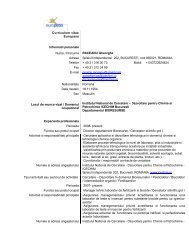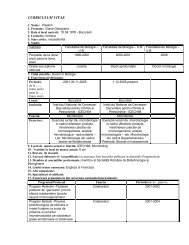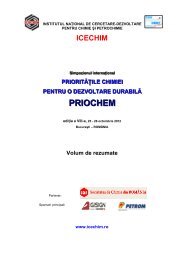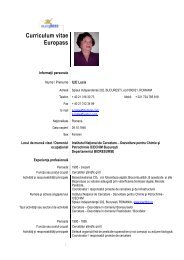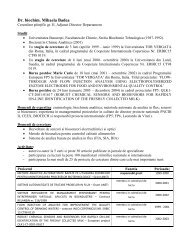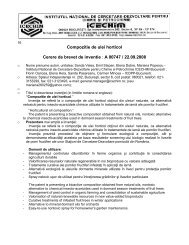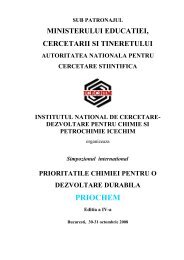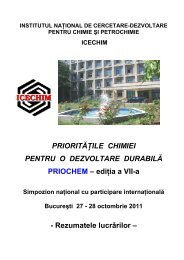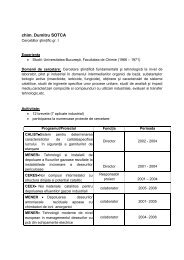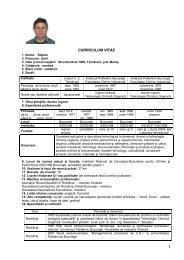Biomasa este un termen generic care cuprinde o ... - ICECHIM
Biomasa este un termen generic care cuprinde o ... - ICECHIM
Biomasa este un termen generic care cuprinde o ... - ICECHIM
You also want an ePaper? Increase the reach of your titles
YUMPU automatically turns print PDFs into web optimized ePapers that Google loves.
68The processing of the new copolymer presents a certain number of difficulties, which havebeen successfully overcome in cooperation with our American partners. The lecture willoutline the principles <strong>un</strong>derlying the synthesis and properties of the new copolymer.Com<strong>un</strong>icari orale1. ADVANCED Fe-NANOSTRUCTURES FOR ARSENIC REMOVAL FROM WATERSTREAMSMiroslava Vaclavikova, Marek Matik, Stefan Jakabsky and Slavomir HredzakInstitute of Geotechnics, Slovak Academy of Sciences, Watsonova 45, 043 53 Kosice, SlovakiaE-mail: vaclavik@saske.skIncreasing concentrations of arsenic in gro<strong>un</strong>dwater have been recognized as one of themajor environmental problems aro<strong>un</strong>d the world. Arsenic enters the environment through bothnatural and anthropogenic sources, including geothermal water, weathered sedimentary rocks,and wastes from the metallurgical, glassware, mining, and ceramic industries, as well as by useof arsenical pesticides, herbicides etc. The toxicity and mobility of arsenic varies with itsvalence state and chemical form. As(III) is generally more toxic to humans and four to tentimes more soluble in water than As(V). Numerous treatment technologies such as ionexchange, adsorption, ultrafiltration, reverse osmosis, and adsorption-coprecipitation by metals(predominately ferric chloride) followed by coagulation have been developed for the removalof arsenic from aqueous media. The adsorption has been considered as most promising methodfor arsenic removal from waters. The contribution presents the synthesis and detailedcharacterization of iron oxides based nanoparticles (Akaganeite -FeOOH). New nanosorbenthas been used for removal of arsenic species from model aqueous solutions. The adsorption hasbeen investigated in batch–type equilibrium experiments at constant ionic strength of 0.01MNaNO 3 as well as in the absence of ionic strength at pH 3.5–4. The initial concentration ofAs(V) in model solutions was in range 20–1000 mg.L -1 and adsorbent dosage was 2 mg.L -1 . Alladsorption experiments were performed in rotary shaker at ambient temperature (22+1°C).After 24 hours of mixing, the equilibrium metal concentrations were determined by AtomicAbsorption Spectroscopy. The amo<strong>un</strong>t of metal sorbed by the sorbent was calculated from thedifference. In order to describe the results of adsorption process, the adsorption isotherms weremodelled using Fre<strong>un</strong>dlich and Langmuir equations. It was observed, that water solutions



